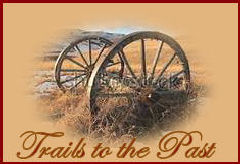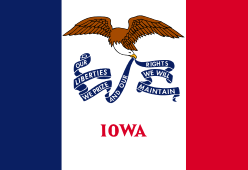Trails
to the Past of Iowa is excepting any
donations of genealogy materials that you may
have such as marriage announcements, news
articles, old obituaries, births, (you do not
need the birth certificate) just the
information, and biographies. If you have
any of these items please contact
me Marie
Miller the Iowa
State Administrator.
Union
County
The first permanent European-American
settlers came in 1849 and 1850. Mormons had
earlier established Mt. Pisgah in the eastern
part of the county as a way station as they
traveled west, but had left this area by 1848.
Settlers used Pisgah as a base to establish
farms along the Grand and Platte rivers that run
through the county. They found a market for
their produce with the emigrants traveling
overland to California to take part in the Gold
Rush. Travelers often sought shelter with the
settlers along the way. In 1851 one settler
counted 2,600 teams driven by emigrants to
California; they often drove herds of sheep and
cattle, trying to get animals to the gold fields
to feed the miners, but many died along the
way.
The
first village was Petersville, founded in 1853,
the same year that the county was organized. The
county was named for the union which many people
wanted to preserve, at a time of rising tensions
between the North and the
South.
After
the American Civil War, railroad construction
linked the areas of the county, giving rise to
new towns, and gave access to other markets. In
1868 the railroad reached Afton, Iowa, and the
next year Creston, the county seat, was made a
division point. The railroad built service
facilities there, a roundhouse and related
structures. The railroad brought immigrants and
migrants to the area, who were attracted to the
fertile soil as farmland. Immigrants came from
across central and eastern Europe, as well as
from eastern states of the US. The Burlington
Northern Santa Fe Railroad (BNSF) continues to
be important in the area, serving as the chief
network for hauling grain and coal. Over the
years, it drew workers from industrial cities
such as Chicago to
Creston.
The
county has a fair each year. In the late 19th
century, southwestern Iowa claimed the title of
Bluegrass Capital, having cultivated bluegrass
throughout the area. In 1889 the Bluegrass
Association was founded, made up of
representatives of the 18 counties in this
region. They built a Bluegrass Palace on the
Union County Fairgrounds. It was designed by
Louis Syberkro, an artist, and constructed by J.
C. Woodruff, both of Creston. Made of sod and
baled hay on a wood frame, the building was 100
feet square, with corner turrets and a central
tower 92 feet high. It held exhibits of farm
products and resource commodities from counties
of the association, including wood, coal,
sandstone, and marble. The palace was such a
success that the Bluegrass Association
commissioned a larger one the following year,
which supplied about three times as much space.
In a separate wing was an auditorium large
enough to hold 2,000
people.



